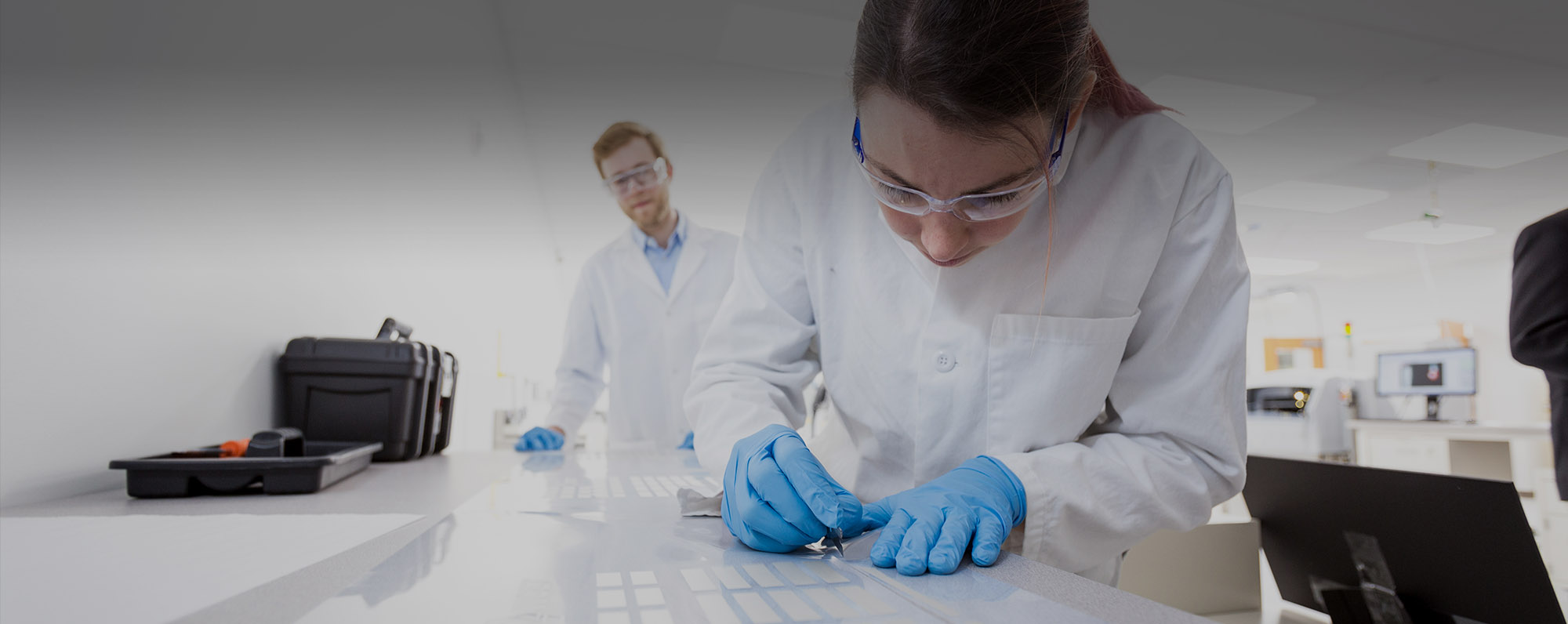Hrudya Nair- 2018 CEBR RET
COBDEN RESEARCH GROUP – Nanodevice Physics Lab
Preparation and Characterization of Graphene
Overview:
In this lab students will learn to exfoliate graphite flakes into few-layer graphene and visualize them using an optical microscope. Students may also use an AFM to measure layer thickness and submit a lab portfolio based on their experiments.
Graphene Preparation and Characterization
Background:
Nanomaterials are widely classified as 0D, 1D and 2D and they became an interesting topic of research in the past decade owing to their unique electrical, mechanical and optoelectronic properties and large surface to volume ratio. For example, 2D nanomaterials like graphene is conducting and can be used as gate electrode, hexagonal Boron Nitride (h-BN) is insulating and can be used as a dielectric in capacitor, MoS2 layer is used as a semiconductor and so on.
Graphene is a monolayer of graphite with a thickness of 0.34 nm and consists of sp2 hybridized carbon atoms [1]. It is often described as one of the thinnest, stretchable and strongest 2D materials with very high thermal conductivity, current density, intrinsic mobility etc. [2, 3] It would be possible to tune material properties like density of states, band gap, electronic excitations, transport etc. by understanding the physics behind. A thorough understanding of the materials properties and the physics governing the materials at nanoscale is crucial for their application in industry [4].
Research Connection:

Figure 2: Nanodevice fabricated by Cobden research group [5]
There are numerous methods to prepare 2D nanomaterials from bulk materials [6, 7]. Electronic applications require clean and dry nanomaterials. One of the most common, simple and reliable methods to obtain clean and dry 2D nanomaterials is mechanical exfoliation using an adhesive tape as the transfer medium. These exfoliated fragments are further immobilized on the desired substrate surface by van der Waal’s forces. The obtained 2D nanomaterial is identified using an optical microscope whose optical response depends on the number of atomic layers in the flake. An AFM could be used to measure the nanomaterial thickness.
Preparation and characterization of graphene
Objective:
To prepare graphene by mechanical exfoliation and characterize it using optical microscope.
Materials & Sources:
- Graphite flakes
- Wafer handling tweezers
- 280 nm SiO2/ 500 µm Si wafers [<100> P/Boron doped Silicon wafer with 0.1-0.02 ohm-cm resistivity having 285 nm Silicon dioxide, Purewafer]
- Scotch Tape
- Digital Hot plate
- IPA, DI water
- Diamond cutter
- Optical Microscope [Olympus BX51M with lens 5x, 20x, 80x]
- Atomic Force Microscope [AFM, Veeco]
Procedure:
- Take a SiO2/Si wafer as substrate.
- Clean it using IPA, DI water followed by air drying. You may also keep the substrate on a hot plate for 30 seconds to remove any moisture present.
- Scribe the substrate using a diamond cutter to break a desired piece of SiO2/Si. [Figure 1a]
- Take a piece of scotch tape sufficiently larger than the selected substrate length. Fold the edges. [Figure 1b]
- Take a few graphite flakes using a cleaned tweezer and drop them on the sticky side of the tape.
- Gently fold and unfold the tape to spread the flakes evenly throughout the tape. [Figure 1c]
- Now place the tape upside down on the selected SiO2/Si wafer and gently press the tape. [Figure 1d]
- Now place it on a hot plate at 100 °C for 2-5 minutes. [Figure 1e]
- Take it out and allow it to cool to room temperature for 10-15 minutes.
- Gently and carefully remove the tape from the wafer. [Figure 1f]
- Inspect the substrate using an optical microscope in varied magnification to see the exfoliated few layer graphene. They appear in different colors due to phase contrast depending on the layer thickness of the SiO2 and flakes. Try to identify a monolayer, bilayer, or few layer graphene.
- Prepare a lab portfolio will all the details of your experiment.

Figure 3: Graphite exfoliation: (a) cleaving substrate using diamond cutter, (b) tape with folded edges, (c) tape with graphene/graphite flakes (d) sticking and pressing tape onto substrate, (e) heating substrate on hot plate, (f) substrates after removing tape
Extensions:
Influence of exfoliation time and temperature on exfoliated 2D materials
Students can study the effect of exfoliation temperature and duration on the exfoliation process and yield of graphene.
AFM imaging and estimation of 2D nanomaterial thickness
Students can explore imaging parameters to get good AFM image. They may also look for graphene free of defects (bubbles, folding etc.) and measure its thickness.
References:
[1] The Rise of Graphene, Nature, 6, 183 – 191 (2007)
[2] The Physics of Nanoelectronics, Tero T. Heikkila
[3] Controlling the Electronic Structure of Bilayer Graphene, Science, 313, 951-954 (2006)
[4] Nanoelectronics: Principles and Devices, Mircea Dragoman and Daniela Dragoman
[5] Ferroelectric switching of a two-dimensional metal, Nature (in the press) (2018) [https://www.nature.com/articles/s41586-018-0336-3]
[6] Methods of Graphite Exfoliation, J. Mater. Chem., 22, 24992 – 25002 (2012)
[7] Reliable Exfoliation of Large-Area High-Quality Flakes of Graphene and Other Two-Dimensional Materials, ACS Nano, 9(11), 10612-10620 (2015)



